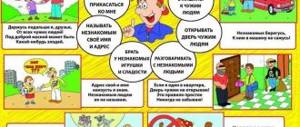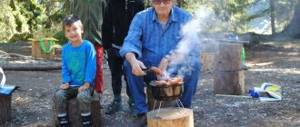Water safety for preschoolers (recommendations for parents)
Maria Yankina
Water safety for preschoolers (recommendations for parents)
Young children usually have no natural fear of water and therefore they boldly climb into it, completely unaware of the dangers that threaten them. Preschoolers are often unable to adequately assess the level of threat, which means that the main task of ensuring their safety on the water falls on their parents.
Babies are babies, and an adult must vigilantly supervise the process of bathing children, especially preschool age, when the child is still quite weak and disorganized and when he can drown in a matter of minutes.
Water safety rules for swimming - swimming in open water
· For swimming, use only circles and vests intended for use in open waters; they should have thicker walls and, preferably, several autonomous chambers. So that the child does not drown if one of them is punctured.
· Always be near a child who is in the water. Don't take your eyes off him. A preschooler can go underwater in a second and choke.
· Try not to take preschoolers on boats, pedal boats or other watercraft, as this can be dangerous. But even if you take your baby, always put a life jacket on him while still on the shore.
· Swim in specially designated areas with a clean, inspected bottom, and where there is a lifeguard and a medical center.
· If you are swimming with children in nature, then choose a clean, shallow place with a current of less than 0.5 meters/second. First check the bottom yourself; it should not be squishy and without sharp objects. Always be near the kids.
· Do not allow preschoolers to swim far from the shore and dive in shallow places or where the bottom is unfamiliar.
Swimming water safety rules - swimming in inflatable pools
· Never allow children to dive into inflatable pools.
· Do not leave preschoolers unattended, even in a small basin. The baby can fall face first into the water and drown; his arms are still too weak for his body weight and therefore it is difficult for him to rise.
· Protect children from unauthorized access to the pool as much as possible so that they do not go swimming without permission. To do this, remove the ladder, install a barrier, leave no chairs on which you can climb inside, put a thick protective cover on the top (that will not fall under the weight of a child or two), or drain the water from the pool. A reliable barrier against children can be considered a barrier with a height of one and a half meters, in which either there are no horizontal crossbars, or they are too small to climb comfortably.
· If you have a large inflatable pool with a powerful drain and fill system, then make sure that the exhaust system does not create powerful pressure that could suck a child.
General safety rules for parents when bathing preschoolers
· Never swim in bad weather.
· Always explain to children the rules of behavior on the water and do not set a bad example for them.
· Never take children swimming while intoxicated.
· Supervise children swimming.
· Control the emotional state of the preschooler so that when he plays too much, he does not drink too much water.
· If your preschooler is already a good swimmer and diver, then do not allow him to dive in places where the depth is less than 2.5 meters.
· Do not allow preschoolers to swim alone, always stay at a distance of up to a meter from them and secure the kids with your hand, even if the child is swimming with an inflatable ring or vest.
· When swimming, try to always have a lifeguard or instructor on duty, but never rely only on them, remember that you are primarily responsible for the safety of your own child on the water.
· Make sure that the swimming routes of small children do not intersect with older ones, this can lead to injury.
· Do not swim with children in places where it is prohibited.
· Do not swim behind buoys, do not jump into the water from rocks or in places with an unknown bottom.
· Try to keep your child in your line of sight when he is in the water.
· For children who are poor swimmers, use special safety equipment, inflatable arm sleeves or vests.
· Strictly supervise your child's exposure to water to avoid hypothermia. After swimming in salt water, you need to wash in fresh water.
· Older teenage children, if they go to a pond on their own, should swim only in specially designated places with a safe, proven bottom, in the absence of deep holes, strong currents, whirlpools or large waves.
· Sufficiently old children should already know not only the rules of behavior on the water and be able to swim, but also have the skills to behave in critical situations. They must understand how to behave if their leg cramps, be able to identify a drowning person, provide first aid, etc.
· Teach the basics of drowning rescue techniques; if you cannot do it yourself, then go to a swimming instructor.
Use simple, easy-to-understand safety rules and poems, pictures, and stories to explain them.
For example, poems:
We will splash in the water, By the shore where our mother placed us, We are not afraid of the depths at all, We are just aquatic people who all know the rules! We follow all the rules of swimming on the water, so we know that there will never be trouble. We are obedient children, we love our parents, and that’s why we know the rules, and we will never forget them.
So, preschoolers need to clearly understand the following water safety rules:
- You cannot go or swim deep into the water.
- You cannot swim in the water without adult supervision.
- You cannot dive into water where it is shallow, where there is a hard or sharp bottom.
- Don't dive into the small inflatable pool.
— You cannot dive into the water from boats.
- You can dive into the water only where there is a good bottom, sufficient depth, and where you are allowed by adults who should be nearby.
— You cannot walk along the edges of piers, piers, breakwaters or other places where you can fall into the water.
“You don’t need to stay in the water for a long time, you can get very cold.”
— When playing with children, it is forbidden to push them into the water or hold them under water, they may choke.
— You can’t swim in bad weather.
The rule for those who cannot swim or are poor swimmers is when swimming, use an inflatable ring, a vest, and arm pads. Do not swim far from the shore, even on an inflatable ring or vest - it is dangerous. If you see someone drowning or someone feeling bad, tell an adult about it. If you swallowed water, are cold, have a cramp, or just feel unwell, get out of the water!
Be careful on the banks of a river, lake or sea, there may be holes even close to the shore.
You cannot play games in water that involve grabbing an opponent and holding him under water; your friend may choke and lose consciousness.
Do not ignore the rules of behavior on the water and do not allow children to do this.
Water is a dangerous element for people.
Even a calm surface of water, despite its apparent safety, is fraught with threats.
Moreover, troubles usually happen not to those children who cannot swim, since they usually do not go into the water deeper than waist-deep, but to those who imagine themselves to be excellent swimmers. Many accidents occur precisely because of swimming in prohibited areas.
What parents need to know about children's safety on the water
· You should bathe an hour and a half after eating.
· If the water temperature is less than +16 °C, then swimming is not recommended at all, as the cold may cause convulsions or loss of consciousness.
· When the water temperature is from +17 to +19 °C and the air temperature is about 25 °C, you should not stay in the water for more than 10-15 minutes.
· You should swim only in specially equipped safe places. If you decide to swim while in wild nature, then choose a place with clean water, up to 2 meters deep, with a flat gravel or sandy bottom and where the water flow is weak, that is, does not exceed 0.5 m/s (to check throw a sliver or stick into the water).
· Always check the bottom thoroughly and supervise children swimming. Children should swim close to the shore.
· Never swim in wet areas.
· If you are drunk, do not let children into the water; if left unattended, they may get into trouble.
· It is forbidden to swim beyond the buoys, and if there are none, then it is too far from the shore;
· You must not swim close to ships.
· You should not jump into the water in places where the bottom is shallow or unfamiliar.
· You cannot jump into the water from boats, piers, bridges and other places not intended for this purpose.
· You should not suddenly jump into cold water after overheating in the sun or after a long run; this can cause shock and loss of consciousness or cardiac arrest. You must first rinse with water.
· You cannot swim in a storm or with strong waves.
· Do not swim in bodies of water whose shores are lined with large stones or concrete slabs; they become covered with moss, become slippery and are dangerous and difficult to get out of.
· Air mattresses and rings are intended for swimming only near the shore. Follow basic safety rules and be vigilant on the water.
Enjoy your holiday!
First round of fire safety quiz
The leader asks the children one by one. A correct answer is awarded one point.
- If the fire ceases to be controlled, what is it? (Fire).
- What is the name of the team of people who come to extinguish fires? (Firemen).
- What tools do firefighters use when putting out fires? (Fire hoses, picks, shovels, crowbars, axe, bucket, sand).
- How can an ordinary person put out a fire? (Fire extinguisher).
- What are wounds caused by fire called? (Thermal burns).
- What should every person do if his clothes are on fire? (The person must lie down on the ground and roll on the ground to put out the fire.)
- What is the urgent exit of people from premises in an emergency called? (Evacuation).
- If the clothes of a person next to you catch fire, what should you do? (Throw a cloth over it and press firmly to put out the fire).
- Is it allowed to hide in hard-to-reach places during a fire? (No, you can’t. So a person only interferes with the rescuers doing their job).
- What should you do if the room is very smoky and it is impossible to breathe? (Take any tissue and pee on it, apply it to your nose and mouth).
- In the event of a fire, are windows and doors allowed to be opened? (No, this leads to additional oxygen supply, and the fire will flare up with renewed vigor).
- What is more dangerous: a can of gasoline or an empty can? (Empty, because vapors of gasoline and air are formed in it, and this is explosive).
Fire extinguisher - What will help most effectively cope with extinguishing flammable materials? (Any piece of wet cloth).
- If the fire is completely extinguished and there is no re-ignition, what is this called? (Extinguish the fire).
- What should be on a fire shield? (Bucket, hook, shovel, sand, fire extinguisher).
- If during a burn the area becomes charred, what is this sign? (4th degree burn).
- What does a firefighter attach to a lifebelt? (Fire carbine).
- Why do you need to constantly whitewash chimneys in attic spaces? (This way, cracking can be detected on them first and the problem can be corrected in time).
- Why, if gasoline burns, is it extinguished with special foam or sand? (You cannot extinguish gasoline with water, because gasoline floats on water due to its light specific gravity and water cannot extinguish it effectively).
- What should you do if the fire alarm goes off in the room? (Calmly leave the premises using a certain exit pattern, without making it difficult for other people to exit).
Summing up the first round. The three players with the fewest points are eliminated.
Food on the beach
You need to eat 30-60 minutes before swimming. It is better if lunch is light, without fatty foods. But you need to drink in the sun constantly, so clean drinking water should be at hand. If desired, water can be replaced with juice. Juicy fruits (apples, peaches, watermelons) will help quench your thirst and maintain an optimal level of water in the body. However, it is important to be able to wash your hands and fruit before eating.
Bread, cookies, vegetables and fruits will help satisfy your hunger. You should not take dairy products. It is strictly prohibited to feed children food purchased from trays on the beach. Such food will not differ in cleanliness and sanitary standards.
Priority preventive measures
From a trip to nature or to a tourist camp, a child expects only positive emotions, without thinking about the existing dangers and risks. Preventing them is the task of adults.
Here's what else you can do “on the shore”:
- The child can be allowed to swim and play active games in the water 1–1.5 hours after the last meal. During the digestive process, the main blood flow is concentrated in the stomach area. An adult will not even feel that his muscles are slightly weakened at this time. However, for a fragile child’s body, the outflow of blood from the muscles of the arms and legs may be unsafe.
- To avoid convulsions or loss of consciousness, it is strictly not recommended to let children into water whose temperature is below 17 degrees.
- It is better to swim in specially designated areas.
- When you are near a body of water outside the beach area, you must carefully check the bottom. There should be no holes, foreign dangerous objects, underwater rock ledges or stones that could cause injury.
- The strength of the current should be checked and correlated with the physical capabilities of the children. You can throw a sliver of wood into the water and by the speed of its movement you can understand whether there is danger or not. A current whose speed does not exceed 0.5 m/s is considered safe.
First aid kit - an assistant to caring parents
You shouldn’t go to the water with your child without a basic set of medications. No one is immune from minor injuries, and it is better if the essentials are at hand.
- Products that protect against ultraviolet radiation for children (SPF level 30 and higher). When buying a cream or spray, you should check the age of the baby.
- First aid drug for thermal burns.
- Hydrogen peroxide.
- Antibacterial plaster, bandage and cotton wool.
- Insect repellent (cream or spray). Also see the approved age for use in children.
- Antihistamines (to avoid allergic reactions).
It is very important that the child is vaccinated against tetanus, since this infection is dangerous when contracted on the beaches.
Choosing a place to stay
It is necessary to pay attention when choosing a place to relax. A family vacation with children on unequipped and “naked” beaches is not the best idea. It's cheap and accessible, but in the end, such a pastime is unsafe and can turn into a tragedy.
It is better to ask in advance whether a particular place has undergone an annual inspection for safety and compliance with sanitary standards. If the relevant authorities have not confirmed that the beach is ready for work, then it is better to postpone the idea of going there, because a small child could be injured or, even worse, contract a serious infection.
It would be a good idea to find out whether the beach meets the basic criteria for a safe place to relax. Here are the main points that will help you with your choice:
- The beach is located away from pastures, industrial enterprises, and agricultural land.
- The area is clean and zoned with markings from special signs, as well as convenient descents and entrances, awnings and awnings. It is important that the territory has a clean toilet, a shower with fresh water, a changing cabin, and trash cans.
- Be sure to have buoys on the water.
- The water should be clean and the bottom should be clearly visible. The presence of plants, debris or snags at the bottom of the reservoir is unacceptable. A flat sandy surface without depressions, with a gradual deepening into the distance - this is the ideal bottom of a reservoir.
- The acceptable depth of a bathing area should not exceed 130 cm (this makes it more convenient to teach a child to swim).
- Safety of vacationers. Responsible owners will always place a cabin on the beach with a lifeguard instructor who has a first aid kit, life preservers and a fire extinguisher.








